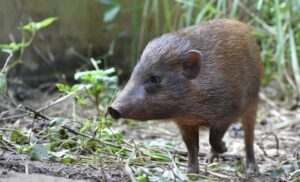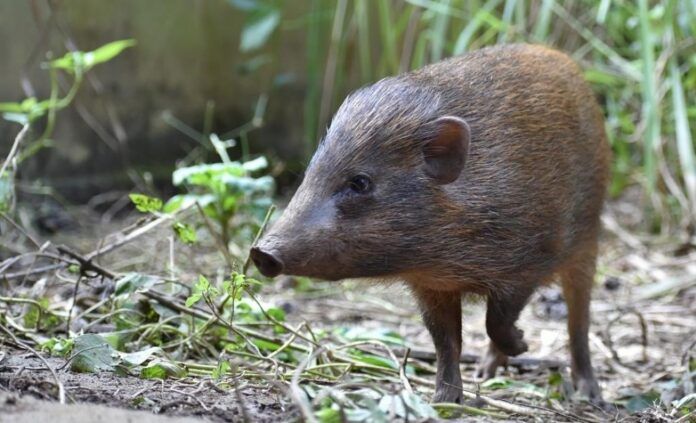African Swine Fever threatens India’s Pygmy Hog, other Asian wild pig species: Pygmy Hog’ Conservation for Wildlife Protection in India
The world’s rarest and smallest wild pig species is “extremely susceptible to extinction” from ASF due to its small populations and limited range

An adult female pygmy hog. Photo: Parag Deka
African Swine Fever (ASF), the livestock illness that has decimated porcine populations across Asia since its advent in China in 2018, could deal a lethal blow to the pygmy hog, the world’s rarest and smallest pig, according to an article in the journal Science.
The article flagged the danger, citing damages caused to wild suid populations in other parts of Asia, especially the south-eastern part of the continent.
For instance, it noted that “the bearded pig used to be the most common species you would find on camera traps” in Sabah, Malaysian Borneo.
But over the past 16 months, camera traps have recorded “zero hits” of the animals, the writeup quoted a field ecologist in Malaysia as saying. The true impact of ASF on the bearded pig “is unknown”, the scientist quoted, added.
Fewer bearded pigs in Borneo would have a ripple effect on other species such as Bornean tree frogs which breed in their wallows as well as dung beetles that feed on their scat.
“Meanwhile, other wild pig species, such as the pygmy hog of India and the Visayan warty pig of the Philippines, both critically endangered, are also at risk. Their small populations and limited ranges have made them “extremely susceptible to extinction,” warns Matthew Luskin, an ecologist at the University of Queensland, St. Lucia,” the article, published on Science’s portal on April 25, 2023, noted.
A success story
The pygmy hog is a conservation success story for India. Once thought to be extinct, it was rediscovered in 1971. The Durrell Wildlife Conservation Trust, United Kingdom, initiated the Pygmy Hog Conservation Programme in 1995.
It partnered, initially, with the International Union for Conservation of Nature/Specialist Survival Commission Wild Pig Specialist Group, Assam Forest Department and the Union Ministry of Environment, Forest and Climate Change.
The non-profits EcosystemsIndia and Aaranyak joined later as local partners.
Pygmy hogs were brought into captivity in 1996 to start the recovery programme. Between 2008 and 2022, 152 individuals have been reintroduced into four protected areas (PAs) in Assam, including the recent release of 36 individuals in Manas National Park.
Between 2011 and 2015 animals were reintroduced into the Orang National Park, successfully establishing a population there. Currently, the captive breeding programme maintains two populations, totalling 80 individuals.
One captive population is at the Pygmy Hog Research and Breeding Centre, at Basistha, in the foothills of the Garbhanga Reserve Forest, on the edge of Guwahati.
The other is The Pygmy Hog Prerelease Centre, Potasali. It is located at the edge of the Balipara Reserve Forest.
Parag Jyoti Deka, Programme Manager, Threatened Species Recovery Programme, Aaranyak and Project Director, Pygmy Hog Conservation Programme, Durrell Wildlife Conservation Trust, told Down To Earth:
In April 2020, when the disease arrived in Assam, we immediately upgraded the biosecurity protocol that I, along with my colleague, Andrew Routh, head veterinarian at the Durrell Wildlife Conservation Trust, UK, had designed for both breeding centres. At the same time, we also conducted a disease risk analysis (DRA) with the involvement of the Royal Veterinary College, UK and Zoological Society London. According to the DRA, our upgraded biosecurity protocol is at par for mitigating risks posed by the ASF.
But it is the wild populations of the pygmy hog that Deka is really concerned about.
“From what we know, there is no ASF in and around Orang National Park as there is an almost negligible domestic swine population there. So, the chances of ASF spreading from domestic pigs to wild boar in and around Orang is miniscule,” according to Deka.
But in Manas, there are records of wild boar coming out of the park and into the fringe villages. That is where local tribal communities usually have backyard pig-keeping practices. “There is every possibility that these pigs could get infected and pass it on to wild boar, which, in turn could infect the pygmy hogs,” he added.
Deka noted that the epidemiological impact of ASF on pygmy hogs was not known currently since it is a novel disease for the species.
“But since it is a porcine species, the impact could be similar to domestic pigs. In other words, there could be high mortality. That will have a serious impact on the wild population,” he said.
Read more:
SOURCE-https://www.downtoearth.org.in/news/wildlife-biodiversity/african-swine-fever-threatens-india-s-pygmy-hog-other-asian-wild-pig-species-science-article-89008


